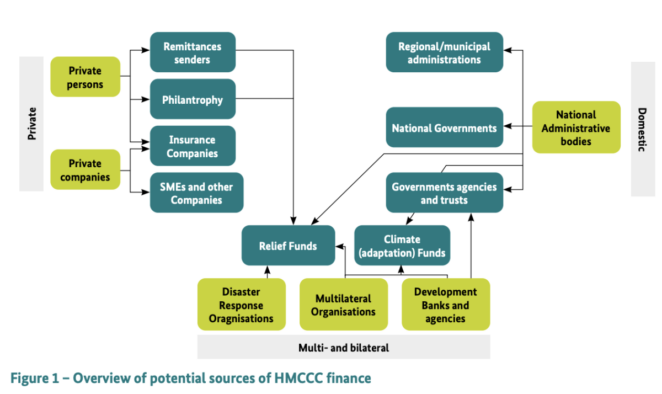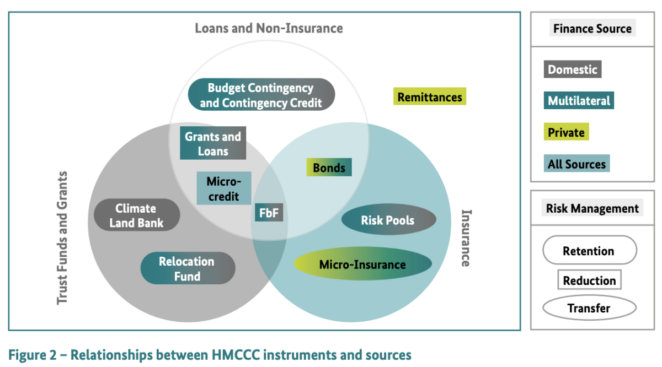The Landscape of Financing Options to Address Human Mobility in the Context of Climate Change

Introduction
Climate change-induced, slow-onset processes and extreme weather events have been worsening and increasing over the last few decades and, as a result, human mobility has been on the rise. Changing climates are forcing people to leave their homes in search of better economic opportunities and slower environmental changes, such as water scarcity and sea-level rise, are making certain areas uninhabitable. Disasters are destroying livelihoods and causing displacement and entire villages are undertaking planned relocations to avoid inevitable loss and damage.
The implementation of timely and diversified financing measures can dampen the effects of climate shocks, preserve and rebuild livelihoods and significantly reduce future costs. This study presents an overview of sources of financing for human mobility in the context of climate change (HMCCC) and a list of 10 financial instruments and tools for addressing this issue.It will explore where such financing comes from and detail the innovative financing solutions that are currently being implemented, piloted and suggested. The study pays particular attention to the gender transformative power of the tools and instruments presented and the extent to which the COVID-19 pandemic is affecting financing flows and options.
This weADAPT article is an abridged version of the original text, which can be downloaded from the right-hand column. Please access the original text for more detail, research purposes, full references, or to quote text.
Sources of HMCC finance
The study starts by discussing the key sources of HMCCC finance, covering national, multilateral, bilateral and private sources.
- At the national level, government budgets, loans granted in the context of a disaster and financial tools, such as bonds, provide the majority of financing.
- At the multilateral and bilateral level, development funding in the shape of loans and grants through multilateral climate funds, such as the Green Climate Fund (GCF) or the Adaptation Fund (AF), or direct development financing through development agencies (e.g. GIZ) represent some of the most important sources of funding for HMCCC activities.
- Disaster response organisations also play an important role at the international level with their contributions to disaster relief funding and now with more innovative anticipatory actions, such as the forecast-based financing (FbF) approaches being pioneered by the Red Cross Red Crescent.
- In the private sphere, sources include philanthropy, remittances and private companies. The most important in terms of volume and impact are private microinsurance offerings and remittances.
Refer to the full publication to explore each of these sources in detail.

Financial Tools and Instruments
The study then details 10 financial tools and instruments: FbF, microcredit, bonds, grants / loans / loan forgiveness, budget contingency, microinsurance, sovereign risk pools (SRPs), remittances, relocation funds and climate land banks (CLBs).
They are not mutually exclusive and each of them can play an important role, as part of a diversified risk portfolio, in dealing with the eventualities of climate change impacts on human mobility. The instruments presented can be divided into different risk categories, namely risk retention, risk transfer and risk reduction.
Their links to HMCCC vary depending on whether they correspond more to micro-policies (e.g. microinsurance and microcredit), with clearer direct links, or to macropolicies (e.g. SRPs and bonds), where funding can subsequently be channelled into micro-policies. Some instruments relate to all aspects of HMCCC, for example, remittances, while others are specifically associated with one particular aspect, for example, relocation funds to resettle vulnerable populations.
The financing tools and instruments implemented in relation to HMCCC not only support people generally, but can also lead to positive gender transformative outcomes. Typically, in developing country contexts, women are more likely to be affected by climate change and climate change-related disasters although the exact impacts are very situation dependent. With the aim of feeding two birds with one scone, practitioners and policy-makers can look to embed (preferably) gender transformative (or at least gender sensitive) elements in their institutional practices on the sources of financing side and in implementation on the tools and instruments side. The role of gender is therefore considered, and examples of either gender sensitive or gender transformative elements are presented for each of the financing instruments in this study as far as insights are available.
Read the full report to find detailed entries for each of the tools covering: a brief description; their link to HMCCC; implementation timing; gender aspects; examples of their use in both slow- and sudden-onset events; and opportunities and barriers.

Recommendations
The analysis of sources of financing and financial instruments resulted in recommendations for different target groups:
- A general recommendation that should be emphasised is that for a better risk portfolio, synergies between instruments need to be leveraged. To this end, capital raised through any type of capital procurement (macro-level policies) can be passed on to those who need it through other instruments.
- The main recommendations drawn from the study for national governments are to improve the role of monitoring and data collection, to further support capacity building to enable financing for addressing HMCCC and to implement a diversified portfolio of instruments to spread risk.
- Finally, the recommendations for international climate governance and bilateral and multilateral organisations suggest that international partners can help achieve better results by offering flexible financing periods and by continuously supporting the process of enabling informed and flexible decisionmaking by governments, for example, through capacity building projects, seed funding, funding programmes and funds dedicated exclusively to HMCCC.
Explore the full publication to view the recommendations in more detail.
Suggested Citation:
Tänzler, D. and Bernstein, T. (2022), The landscape of financing options to address human mobility in the context of climate change. Instruments and approaches to finance measures on climate change related migration, displacement and relocation. Deutsche Gesellschaft für Internationale Zusammenarbeit (GIZ) GmbH/adelphi. Bonn and Eschborn/Berlin.
(0) Comments
There is no content